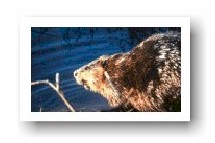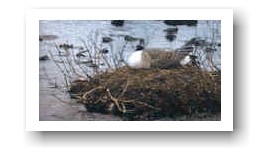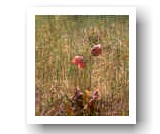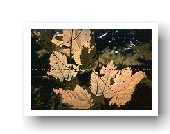Salmonier Nature Park is a wonderful setting for a unique educational experience.
Long, winding, carefully laid trails meander between sensitively designed animal enclosures. Animals at Salmonier Nature Park are part of a unique provincial rehabilitation program for wild animals. They are unreleasable, injured, sick, or orphaned animals that would not survive in the wild. The education program links animals and habitat with school curriculum.
Visiting students, their teachers and parents are treated to a 20-30 minute interpretive presentation in the on-site Interpretation Centre or our outdoor classroom. This presentation may include a puppet show, video or slide presentation, nature games, prop talks or other interpretive media, and is directly linked to the 3 km nature walk which follows. Occasionally, instead of an interpretive presentation, staff will accompany students for a guided trail walk during which they will interpret the many habitats and animals found in the Park.
Salmonier Nature Park’s interpretive staff try to ensure a number of programs are available which link to different grade level curriculum areas. With each season, the scope of our program becomes broader and our offerings become more varied. This is accomplished through having a number of programs available each year and the addition of at least one new program each season.

Existing on-site educational programs
- A Closer Look at Wild Animals (Grades K-1)
- Bears (Grades K-4)
- Boreal Botany (Grade 3)
- Adaptations to Habitat (Grade 4)
- Species at Risk (Endangered Species) (Grades 4-9)
- Eastern Coyotes of Newfoundland and Labrador (Grades 4 through High School)
- Biodiversity (Various levels)
Teachers are encouraged to contact Salmonier Nature Park to arrange a visit for their class or to arrange to have a Park Interpreter visit their class for a presentation on any of the above curriculum-related subjects.
Salmonier Nature Park Outreach Programs
INFORMATION FOR TEACHERS AND YOUTH-GROUP LEADERS
Education Staff at Salmonier Nature Park are available for school visits to offer the following programs, all of which are linked to provincial curriculum topics and outcomes for their grades. Even though specific grade levels are identified for each of these presentations, they can be adapted to suit various grade levels. Please call 229-7888 to make a booking. There are no fees associated with these programs, and park staff will travel to deliver them throughout the Province.
Kindergarten:
A Closer Look at Wild Animals
- Structured as a show-and-tell that includes the specimens being passed around.
- Uses pelts and skulls of wild animals that are closely related to some common domestic pets: Canada Lynx (cats), Coyotes (dogs), & Beavers (rodents).
- Uses a Polar Bear pelt/skull and a Little Brown Bat specimen/skull to illustrate the extreme range of diversity within the mammals, and to illustrate how species are adapted to a wide range of habitats and lifestyles.
- Can be adapted to Grade 1 as well by including discussion of the needs and characteristics of living things. (What does each species need from its habitat? and What do these mammals have in common? and How do their differences allow them to meet their needs in different ways?)
Grade 1:
See modified version of above program (see last point)
Grade 2:
All About Bears
- Structured as a show-and-tell that includes some of the specimens being passed around.
- Covers the biodiversity of the 8 bear species in the world
- Covers the challenges facing many of those species, mostly due to habitat loss.
- Focuses on the 2 species found in NL and their habitats.
- Demonstrates the principle of classifying animals based on similarities and differences in their lifecycles and other adaptations.
Grade 3:
Boreal Botany
- Structured as a PowerPoint presentation supported by some physical specimens as visual aids.
- Introduces the concept of the boreal forest, and uses the local species found in it to examine the needs of plants, their habitats, their reproductive strategies and their interactions with animals.
Grade 4:
Adaptations to Habitats
- Engages the students in a compare and contrast activity using taxidermy specimens of Red Fox and Arctic Fox, developing their observational skills.
- The differences discovered between the two species illustrate how they have become adapted to living in two very different habitats. Behavioural adaptations are discussed as well as physical ones. The differences between Boreal Forest and Tundra are covered as well.
- Ends with a quiz game where the class must guess the adaptive value of a physical or behavioural trait of a NL species.
Grades 4-6:
Species at Risk (commonly known as Endangered Species)
- A discussion of three local species at 3 different levels of the SAR classification: Peregrine Falcon (vulnerable), Newfoundland Marten (threatened), and Piping Plover (endangered). Structured as a show-and-tell with a wildlife-management role-playing game to finish off (the Marten Game).
- Covers the human and natural factors that limit the populations, and the human actions that are being taken to protect them. Engages kids with the idea that their small actions matter in the big picture.
- No longer matched with the Grade 5 life sciences unit, but still very popular with Grade 5 teachers who use it with Language Arts by having the children write about the presentation’s subject matter. (Grade 5 life sciences unit is now focused on human biology.)
- Linked to the Grade 4 curriculum on habitats, because the impact of changes in each species habitat is at the core of all 3 species’ stories.
- Relevant to Grade 6 curriculum, Diversity of Life because the way human actions impact species has broader biodiversity implications.
Grades 4-7:
Eastern Coyotes of Newfoundland & Labrador
- Structured as a PowerPoint presentation supported by some physical specimens as visual aids.
- Linked to the grade 4 curriculum, in that it discusses the success of coyotes in NL as a function of their adaptability to the habitats found here.
- Linked to the grade 6 curriculum by its coverage of the scientific methodology used to study coyotes in the province.
- Linked to the grade 7 curriculum, in that it covers the interactions of the coyotes with other species and elements of the local ecosystem.
- Covers the biological and ecological factors that make Eastern Coyotes so successful in our province, while dispelling many myths about them.
- Teaches people how to avoid attracting coyotes to their residences or campsites, and how to behave safely when encountering them or other predators.
Grade 6:
Natural Legacies: Documenting the Diversity of Life
- Introduces the idea that modern science is a continuation of work started by previous generations of both professionals and amateurs.
- Focuses on the observational and organizational skills needed to be a biologist, and how to classify organisms.
- Driven more by activities than presentation, it uses individual and group work in a pair of activities. The first relates to observational skills and the challenges of observing wildlife. The second relates to making relevant observations and organizing them for future use in the form of a dichotomous key.
- Introduces the idea of citizen scientists, and how amateurs (like kids) can make real contributions to studying local organisms and ecosystems.
Grade 7:
Effects of Exotic Species on Ecosystems
- Ties into the Interactions within Ecosystems unit of Grade 7 curriculum.
- Uses guided in-class discussion, and group brain-storming, to help students realize the scope of interconnectedness within ecosystems and determine the relative potential for good and ill consequences from the unchecked introduction of species.
- Addresses how both biotic and abiotic elements of an ecosystem can be influenced by the introduction of exotic species, and how that new species will be considered to be invasive if its influence on these elements leads to significantly diminished success for populations of one or more native species.
Grades 11 & 12 (Environmental Science 3205):
Consumptive Wildlife Uses and Management Strategies
- Tied to the Environmental Science 3205 curriculum (Chapter 8)
- Also relevant to the Science 1206 unit on the Sustainability of Ecosystems.
- Discusses the basics of population management through sustainable harvesting
- Contrasts the approaches used with small game species versus big game species, and explains the ecological reasons for the differences.
- Examines examples of how the Wildlife Division uses involvement from hunters in their management strategies for various species (such as moose, caribou, and coyotes), and the ecosystems that these species depend on.
- Presentation is supported by some specimens of relevant species as visual aids.
Species at Risk (commonly known as Endangered Species)
- A modified version of the popular Elementary School program that addresses the core concepts in greater depth. Tied to Chapter 4 of the Environmental Science 3205 curriculum.
- A discussion of four local species at three different levels of the SAR classification: Peregrine Falcon (vulnerable), Newfoundland Marten (threatened), Piping Plover (endangered), and Little Brown Bat (a species of Least Concern in NL, but in serious jeopardy over much of its range elsewhere in North America).
- Covers the human and natural factors that limit the populations, and the human actions that are being taken to protect them. Engages students with the idea that their small actions matter in the big picture. Uses the research being done on bats by the Wildlife Division to discuss the complications of inter-jurisdictional study and management of species, and the risks posed by introduced pathogens.
Prepare for your Class Visit to the Park
In order to ensure that your group receives the maximum enjoyment and understanding of the wildlife of Newfoundland and Labrador, Salmonier Nature Park encourages you to take a few minutes to prepare your class for their visit. It will be well worth the effort.
- Ensure your students are divided into groups of 7-10 with an adult leader assigned to each group.
 Explain the park rules to your class before you leave:
Explain the park rules to your class before you leave:
- Do not feed the animals.
- View the animals from the platforms or trails only.
- Do not pick plants.
- No radios or other noisemakers allowed.
- No food on the trails. (Drinks are permitted).
- Stay with your leader at all times.
- No smoking on the trails.
These rules are designed to protect the park and visitors alike. Full cooperation is expected and group leaders should be advised they are expected to enforce these rules and to set a good example for students to follow while at the Park.
What Would you Like to Do While Visiting the Park?
There are several things you may wish to consider before your visit to the Park. Perhaps you can connect your visit to a school project or assignment.
Is your class working on a special project that would benefit from your visit to the park? If so:

- Would it be beneficial for each group in your class to study one particular animal or to gather information on each animal as a class?
- Will your class need notebooks, cameras, binoculars, etc. to help them with their project?
- If a particular animal is involved, let us know in advance. We will attempt to provide some “hands-on” materials which will add an exciting dimension to your visit.
Before your visit, have a class discussion on where the animals at Salmonier Nature Park come from. Many students are not aware that our animals are part of a rehabilitation program for wild animals and that they aren’t here just so visitors can “look at” them. They are actually unreleasable injured, sick or orphaned animals that would not survive in the wild.

- Remind students that Salmonier Nature Park is not your typical zoo. The park is comprised of a varied cross-section of wildlife which includes the animals, plants, insects, and fish of the Province. The “little things” such as the tiny wildflowers, ferns, and bugs are just as much a part of the park as the animals you will see and are just waiting for discovery by you and your group.
Your visit to Salmonier Nature Park has the potential to provide a diverse, multi-faceted educational experience. Remember, just a few minutes of preparation will ensure your visit provides the maximum benefits to your class.
If you are interested in bringing your class to visit Salmonier Nature Park, please see the pre-trip information and call the park for a reservation.
